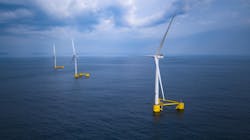As the offshore renewable energy sector grows, efforts to develop the technology needed for the floating wind market are also increasing in scale and scope. Floating wind technology enables wind turbine installation in deeper waters not suitable for bottom-fixed turbines.
As of July 2020, a cumulative total of 73 MW of floating offshore wind power has been installed in Asia and Europe, which is expected to increase to 124 MW by the end of 2020, according to the Carbon Trust. It added that up to 10.7 GW of floating wind is feasible by 2030 and 70 GW by 2040.
Pilot and demonstration projects continue to show the potential for similar or even higher yields from floating turbines compared to bottom-fixed, as they can be installed farther offshore with more wind resources.
Hywind Scotland, the world’s first floating offshore wind farm, confirmed the technical and commercial viability of the technology. The 30-MW pilot park, operated by Equinor in partnership with Masdar, is 25 km (16 mi) offshore Peterhead, in water depths between 95 and 120 m (311 and 394 ft). It began delivering electricity to the Scottish grid in October 2017. According to Equinor, Hywind is a floating wind turbine design based on a single floating cylindrical spar buoy moored by cables or chains to the seabed. It uses a ballasted catenary layout with three mooring cables with 60-metric ton weights hanging from the midpoint of each anchor cable to provide additional tension.
WindFloat Atlantic, the world’s first semisubmersible floating wind farm, became fully operational off Portugal in July 2020. This followed the connection of the last of the three platforms to the 20-km (12.4-mi) export cable linked to the substation at Viana do Castelo.
The 25-MW pre-commercial project is designed to generate energy to supply around 60,000 users per year. It follows a decade-long project by the Windplus joint venture of EDP Renewables (54.4%), ENGIE (25%), Repsol (19.4%), and Principle Power (1.2%). Each of the three platforms is 30 m (98.4 ft) tall with 50 m (164 ft) between columns. Each accommodates an 8.4-MW turbine, claimed to be the largest installed to date on a floating platform.
According to Repsol, WindFloat’s mooring technology allows for installation in waters more than 100 m (328 ft) deep. The design is said to ensure stability in adverse weather/sea conditions.
Two of the platforms were manufactured at shipyards in Setúbal, Portugal, while the other was constructed in Avilés and Fene, Spain. Use of dry-dock assembly brought significant logistical and financial savings, Repsol added, and the platforms were towed using standard (instead of specialized) tug boats.
The company claimed the model could be replicated in other areas where adverse seabed conditions or significant water depth rule out traditional bottom-fixed offshore wind technology.
Saitec Offshore Technologies and RWE Renewables have secured a site in the Biscay Marine Energy Platform (BiMEP) to install the DemoSATH project off the Basque coast in Spain. The project will test the first floating wind foundation connected to the Spanish grid using SATH (Swinging Around Twin Hull) technology. This is based on a twin hull made of modularly prefabricated and subsequently braced concrete elements. The float can align itself around a single point of mooring according to the wind and wave direction.
Marine operations are planned by the end of 2021. With a 2-MW wind turbine, the structure, which will be about 30 m (98 ft) wide and 67 m (220 ft) long, will be assembled in the port of Bilbao. From there, it will be towed to its anchorage point in BiMEP, 3 km (2 mi) off the coast where the water depth is about 85 m (279 ft). Once connected to the grid, DemoSATH is expected to supply electricity to almost 2,000 homes.
The main aim is to analyze its behavior under real operational and extreme conditions, collect data, and gain real-life knowledge from the construction, operation, and maintenance of the unit. The pilot project will last 3.5 years: 18 months for the planning and construction of the plant, followed by a two-year operating phase. According to Saitec, the ultimate objective is to gather experience to implement improvements and optimizations to future commercial projects.
New England Aqua Ventus LLC (NEAV), a joint venture between Diamond Offshore Wind and RWE Renewables, has partnered with the University of Maine to develop the school’s floating offshore wind technology demonstration project. NEAV will invest $100 million to build and demonstrate the VolturnUS floating hull technology at full scale.
The New England Aqua Ventus I demonstration project will deploy a 10- to 12-MW wind turbine on VolturnUS, the floating concrete semisubmersible hull designed by the Advanced Structures and Composites Center at UMaine, 3 km (2 mi) south of Monhegan Island and 23 km (14 mi) off the coast of Maine. Construction, following all permitting, is expected to be completed in 2023. The purpose of the project is to further evaluate the floating technology, monitor environmental factors, and develop best practices for offshore wind to coexist with traditional marine activities. It will supply electricity to the Maine grid.
In April, the Norwegian Ministry of Petroleum and Industry approved the plans for development and operation of the Hywind Tampen wind farm in the North Sea. According to Equinor, the Snorre and Gullfaks platforms will be the first in the world to receive power from a floating offshore wind farm.
The 88-MW wind farm will consist of 11 turbines based on Equinor’s Hywind technology. Kvaerner is building the 11 floating concrete hulls for the wind turbines. It is expected to meet about 35% of the annual power demand of the five platforms Snorre A and B and Gullfaks A, B and C. The wind farm will be about 140 km (87 mi) from shore, between the Snorre and Gullfaks platforms, at a water depth of 260 to 300 m (853 to 984 ft).
Operated from Equinor’s offices in Bergen, Hywind Tampen is scheduled for start-up at the end of 2022. By reducing the use of gas turbines on the fields, the project is expected to help reduce CO2 emissions by more than 200,000 metric tons per year.
Road to commercialization
While floating wind can play a role in the energy transition, challenges to commercialization remain. Phase 2 of the Floating Wind joint industry project, managed by the Carbon Trust, recently addressed some of the technology development challenges in its summary report.
Ramboll looked at the potential impacts of installing larger, next generation turbines on floating substructures. Aside from turbine towers and controllers, it found that only minor modifications would likely be needed for future turbines, and that the required relative primary steel, secondary steel, and mooring mass decreases for larger turbines.
Seaway 7 investigated the challenges associated with floating heavy lift offshore construction and maintenance operations for turbines up to 20 MW. It found that the limited availability and high cost of suitable floating heavy lift vessels in the market at present is a barrier to cost effectively undertaking operations offshore. There is a need for vessels capable of undertaking the required heavy lift operations or alternative lifting solutions, such as climbing crane technology.
BPP Cable Solutions looked at the challenges and assisted in the development of high voltage dynamic export cables required to transport power from floating offshore wind farms. Previous JIP studies have highlighted a lack of suitable dynamic cables currently available on the market. A competition was launched to support cable manufacturers develop and test suitable designs. Five cable manufacturers are currently being supported by the JIP to make these available as products for future projects.
Oceaneering investigated the techniques for assessing the integrity of floating wind farms. It concluded that improvement is needed in both the collection of data and its usage to inform and manage asset integrity for floating wind farms, and for subsea assets. For this there were no ‘quick win’ solutions, but techniques such as a digital twin approach, or unmanned vessels, could support cost-effective solutions.
Dan Kyle Spearman, manager of the Floating Wind JIP, the Carbon Trust, said: “The time is now for the floating wind industry to look to pre-commercial and commercial projects to deliver the cost reduction necessary for the sector to compete with other renewable energy options.”





